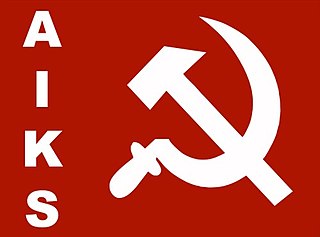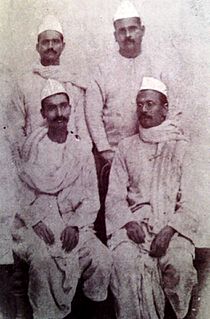
Jayaprakash Narayan, popularly referred to as JP or Lok Nayak, was an Indian independence activist, theorist, socialist and political leader. He is remembered for leading the mid-1970s opposition against Prime Minister Indira Gandhi, for whose overthrow he had called for a "total revolution". His biography, Jayaprakash, was written by his nationalist friend and the writer of Hindi literature, Rambriksh Benipuri. In 1999, he was posthumously awarded the Bharat Ratna, India's highest civilian award, in recognition of his social service. Other awards include the Magsaysay award for Public Service in 1965.

Bihar is a state in eastern India. It is the third-largest state by population and twelfth-largest by territory, with an area of 94,163 km2 (36,357 sq mi). Bihar borders Uttar Pradesh to its west, Nepal to the north, the northern part of West Bengal to the east, and with Jharkhand to the south. The Bihar plain is split by the river Ganges, which flows from west to east. Bihar is also the world's fourth-most populous subnational entity.

The All India Kisan Sabha (AIKS), or All India Kisan Sabha , is the peasants front of Communist Party of India (Marxist), and works for farmers rights and anti-feudal movement in India.

Gaya is a city, municipal corporation and the administrative headquarters of Gaya district and Magadh division of the Indian state of Bihar. Gaya is 116 kilometres (72 mi) south of Patna and is the state's second-largest city, with a population of 470,839. The city is surrounded on three sides by small, rocky hills, with the Phalgu River on its eastern side.

The Congress Socialist Party (CSP) was a socialist caucus within the Indian National Congress. It was founded in 1934 by Congress members who rejected what they saw as the anti-rational mysticism of Gandhi as well as the sectarian attitude of the Communist Party of India towards the Congress. Influenced by Fabianism as well as Marxism-Leninism, the CSP included advocates of armed struggle or sabotage (such as Yusuf Meherally, Jai Prakash Narayan, and Basawon Singh as well as those who insisted upon Ahimsa or Nonviolent resistance. The CSP advocated decentralized socialism in which co-operatives, trade unions, independent farmers, and local authorities would hold a substantial share of the economic power.

All India Kisan Sabha, is the peasant or farmers' wing of the Communist Party of India, an important peasant movement formed by Sahajanand Saraswati in 1936.

The history of Bihar is one of the most varied in India. Bihar consists of three distinct regions, each has its own distinct history and culture. They are Magadh, Mithila and Bhojpur. Chirand, on the northern bank of the Ganga River, in Saran district, has an archaeological record from the Neolithic age. Regions of Bihar—such as Magadha, Mithila and Anga—are mentioned in religious texts and epics of ancient India. Mithila is believed to be the centre of Indian power in the Later Vedic period. Mithila first gained prominence after the establishment of the Videha kingdom. The Kings of the Videha Kingdom were called Janakas. A daughter of one of the Janaks of Mithila, Sita, is mentioned as consort of Lord Rama in the Hindu epic Ramayana, written by Valmiki. The Videha Kingdom later became incorporated into the Vajji confederacy which had its capital in the city of Vaishali, which is also in Mithila.

Sahajanand Saraswati( real name Navrang Rai )pronunciation (help·info) was an ascetic, a nationalist and a peasant leader of India.

The Champaran Satyagraha of 1917 was the first satyagraha movement led by Mahatma Gandhi in British India and is considered a historically important rebellion in the Indian independence movement. It was a farmer's uprising that took place in Champaran district of Bihar in the Indian subcontinent, during the British colonial period. The farmers were protesting against having to grow indigo with barely any payment for it.
Neyamatpur is a village in Gaya district of Bihar, India. The village was a bastion of the Indian National Congress and Kisan Andolan during the British period. "Pandit" Yadunandan Sharma, at the instruction of Swami Sahajanand Saraswati established an ashram here in 1933.

Gogineni Ranga Nayukulu, also known as N. G. Ranga, was an Indian freedom fighter, classical liberal, parliamentarian and farmer leader. He was the founding president of the Swatantra Party, and an exponent of the peasant philosophy. He received the Padma Vibhushan from the president of India for his contributions to the Peasant Movement. N.G. Ranga served in the Indian Parliament for six decades, from 1930 to 1991.
Yogendra Shukla was an Indian nationalist, freedom fighter from Bihar. He served in the Cellular Jail (Kalapani), and he was among the founders of Hindustan Socialist Republican Association (HSRA). Along with Basawon Singh (Sinha) he was among the founder members of Congress Socialist Party from Bihar.
A peasant movement is a social movement involved with the agricultural policy, which claims peasants rights.
Bhumihars, also called Babhan, are a Hindu caste mainly found in Bihar, the Purvanchal region of Uttar Pradesh, Jharkhand, the Bundelkhand region of Madhya Pradesh, and Nepal.
Jamuna Karjee (1898-1953) was an Indian independence activist.
Yadunandan Sharma (1896–1975) was an Indian peasant leader and national liberation figure from the Indian state of Bihar. He had started a movement for the rights of tillers against the zamindars and Britishers at Reora celebrated as the Reora Satyagraha.
Karyanand Sharma (1901–1965) was a nationalist and peasant leader who led movements against zamindars and the British.
Syed Mahmud (1889–1971) was an Indian politician and senior leader in the Indian National Congress during the Indian independence movement and in post-independence India.

Badri Narain Sinha was born at village Saramohanpur in Darbhanga district of Bihar. An officer of Indian Police Service of 1952 batch of Bihar cadre of India, Sinha died in harness as Deputy Inspector General (CID), Government of Bihar. Sinha, described as ‘erudite and knowledgeable police chief’ by noted sociologist-journalist Arvind N Das, was a poet, critic, journalist, and a close associate of Jayprakash Narayan. Apart from the unique alchemy of brain and brawn that he displayed as an administrator and police officer, he was a thinker, littérateur, poet, a secular devout who broke bread with Muslims during the holy month of Ramzan as much as practicing austere Hindu fast during the whole month of Kartik, personifying in his life the multi-faceted moral actions that he highlights as Gandhi's character and, therefore, his message in his writings on the Mahatma.
The All India United Kisan Sabha was a peasants organization in India. The AIUKS was founded around the late 1930s by Swami Sahajanand Saraswati. Sahajanand had broken away from the All India Kisan Sabha in 1945, being opposed to the increasing communist domination of the movement. To form the new AIUKS, Sahajanand gathered Congress Socialist Party members and other Indian National Congress left-wing elements.












